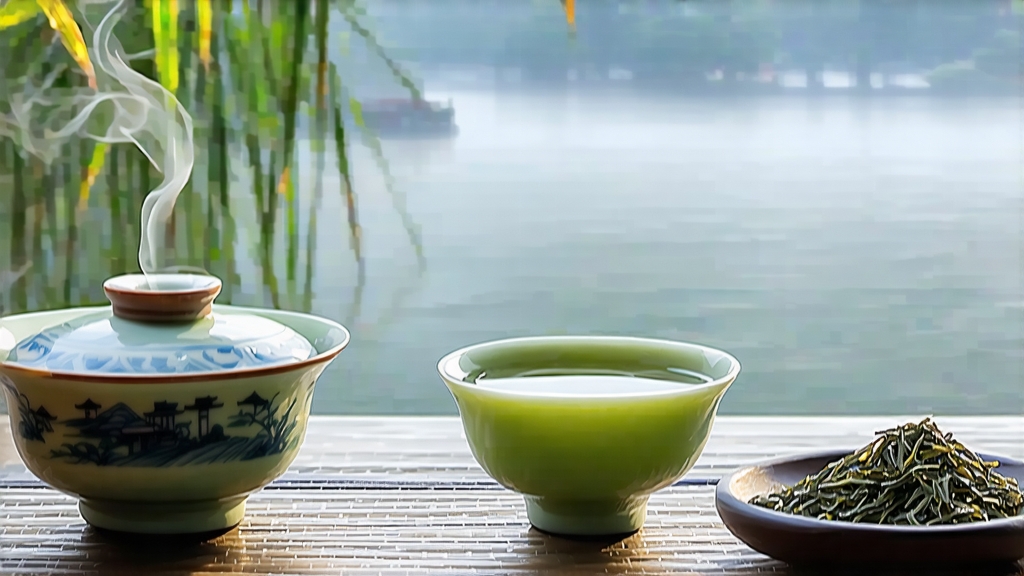
Biluochun, whose name translates literally to “Green Snail Spring,” is one of China’s ten most celebrated teas, yet it remains a quiet treasure beyond the circles of devoted tea lovers. Grown in the mist-locked hills that rise from the shores of Lake Tai in Jiangsu Province, this delicate green tea is distinguished by its tiny, tightly spiraled leaves, an aroma that carries the surprising scent of peaches and apricots, and a cup that glows like pale jade. For international drinkers accustomed to the vegetal briskness of Japanese sencha or the nutty breadth of Longjing, Biluochun offers a softer, more floral path into Chinese green tea.
Historical records first mention Biluochun during the late Ming dynasty, around the seventeenth century, although local legend pushes its story back even further. Farmers on Dongting Mountain speak of a tea so fragrant that wild monkeys were said to pluck the highest shoots, inspiring the alternate name “Xia Sha Ren Xiang”—“Scary Fragrance”—because its perfume was almost alarming. When the Kangxi Emperor visited the region in 1699, court chroniclers write that he was captivated by the spiraled leaf and renamed the tea “Biluochun” to honor its jade-green color and early-spring harvest. From that moment, tribute quantities were rushed to Beijing each year, carried in bamboo-lined chests packed with orange peel to protect the fragile aroma.
Geographically, Biluochun is inseparable from two islands in Lake Tai: Dongting Dongshan (East Mountain) and Dongting Xishan (West Mountain). These granite outcrops enjoy a microclimate in which cool lake air meets warm daytime sun, generating a constant veil of mist that filters light and slows photosynthesis. The result is an increased concentration of amino acids, especially L-theanine, which translates into the tea’s hallmark sweetness and creamy mouthfeel. Unlike many Chinese teas that can be grown across a broad latitude, authentic Biluochun is restricted to these islands and a narrow band of adjacent slopes; move the same cultivar fifty kilometers north and the leaf broadens, the spiral loosens, and the fruit note vanishes.
The cultivars themselves are local descendants of the small-leaf Camellia sinensis var. sinensis. Two clones dominate: “Dongshan Qunti” (a seed-grown population bush) and “Fuding Dabaicha” grafted onto local rootstock. Farmers prize the Qunti for its slow growth and high fragrance, while Dabaicha yields earlier and offers a brighter liquor. Most gardens sit between 100 and 300 meters above lake level, interplanted with peach, plum, and loquat trees. The fruit blossoms coincide with the tea flush, and their pollen drifts onto the sticky leaf hairs, adding layers of aroma that later emerge in the cup.
Harvest begins each year on the Qingming festival, usually April 4th or 5th, when only the unopened bud and the adjacent leaf—still smaller than a fingernail—are plucked. A skilled picker can gather barely 500 grams of fresh leaf in a day; five kilograms are required to produce one kilogram of finished tea. Speed is essential: the leaf is carried in shallow bamboo baskets to prevent bruising, then spread in cool, shaded sheds where withering starts within two hours of plucking.
Withering, however, is brief—twenty to forty minutes—just long enough for the leaf to lose its surface water and become supple. The critical step is shaqing, “killing the green,” performed in woks heated to 180 °C. A craftsperson tosses the leaf with bare hands, feeling for the moment when moisture drops and the grassy edge dissipates. The motion must be vertical, almost violent, to fix the bright color without breaking the bud. After three minutes the temperature is lowered to 120 °C and the leaf is rolled into its signature spiral. Unlike Longjing’s flat press, Biluochun is shaped by a gentle, repeated curl of the wrist against the wok wall, a motion said to mimic the turning of a snail shell. Once the leaf is 70 % dry, it is removed and allowed to rest for thirty minutes, permitting internal moisture to migrate outward. A final low-temperature bake, 60 °C for twenty minutes, reduces water content to 5 % and locks in the aroma.
The finished tea is tiny—barely six millimeters long—and covered in silvery down. When brewed, the leaf unfurls within seconds, releasing a pale, almost luminescent liquor. The first infusion smells of